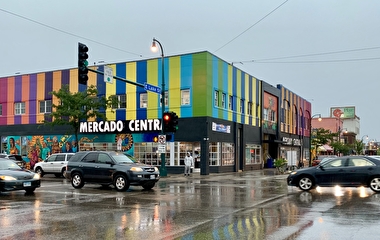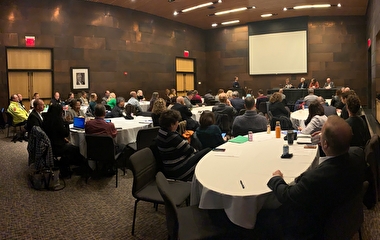originally developed to measure the density of asphalt. Photo:
Vassilios Morellas
During the ongoing COVID-19 crisis, health and sanitation workers nationwide are putting themselves in harm’s way to disinfect public places for the deadly virus. A College of Science and Engineering team in the Minnesota Robotics Institute’s (MnRI) Distributed Robotics Lab is building a robot to lighten their load.
Dubbed the DISinfecting Tele-RObotic sYstem (DISTROY), the machine will be equipped with a robotic arm to disinfect areas like airplane cabins or hospital waiting rooms. Users will be able to operate the robot remotely through a virtual reality headset, moving its arm as if it were their own.
“The objective of the project is, first of all, to mitigate the spread of the contagion,” said Vassilios Morellas, a research professor in the Department of Electrical and Computer Engineering and CTS Scholar. “And second, to increase the confidence in people and let them get back to their normal lives.”
Morellas is co-leading the team, along with MnRI director and CTS Scholar Nikolaos Papanikolopoulos, research engineer Ted Morris, and industry collaborator Mike Bazakos. They are in the process of applying for a National Science Foundation or National Institutes of Health grant to fund the project.
The idea for using immersive technology was spurred by another MnRI project that involves using virtual reality environments to treat mental illnesses in children. Why, Morellas asked, couldn’t the same technology be used to fight COVID-19?
“We wanted to build on a platform that we already have,” Morellas explained. “Because we were looking at the economic effects that this particular contagion has caused, we were thinking, ‘How can we quickly increase public confidence in using transportation again?’”
other transportation facilities. Photo: Shutterstock
To save time, the researchers are using an already-built robot from a previous project with the Minnesota Department of Transportation. Whereas that robot carried sensors to check the density of asphalt on roads, this robot will carry an ionized hydrogen peroxide mist to kill SARS CoV-2, the virus that causes COVID-19.
While the team is focusing on developing the technology for use in the transportation industry—airports, bus depots, and trains—the robot could be tapped wherever it’s needed.
Morellas said the robotic arm will mean more flexibility on the operator’s end. For example, it can more easily disinfect hard-to-reach places, such as in between airplane seats.
Another goal of this research is to reduce the number of workers who put their lives at risk to clean areas potentially infected with the virus. Plus, it could save personal protective equipment (PPE), which is already in short supply.
Morellas believes the DISTROY robot would prove beneficial long after the COVID-19 pandemic passes. Its remote setup could also protect those who perform other life-threatening tasks, such as cleaning up radiation pollution or hazardous chemical spills.
“The role of robotics is basically to give us the tools to do things that would be dangerous for a person to do,” Morellas said. “There are many other occasions when you want to get people out of harm’s way, and you might want to use a robot to do the dirty job for you without [endangering] a human life.”
The researchers expect to have a robot ready for testing within the year.
(Adapted from an article by Olivia Hultgren published on the U’s College of Science and Engineering website on May 19, 2020.)




